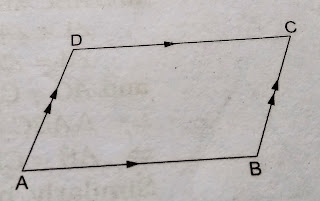Class 8 : Parallelogram with MCQ
Parallelogram: a quadrilateral is called a parallelogram if both pairs of its opposite sides are parallel.
Rhombus: a parallelogram having all sides equal is called a rhombus.
Rectangle: a parallelogram in which each angle is a right angle is called a rectangle.
Square: parallelogram in which all the sides are equal and each angle measures 90 degree is called a square.
Trapezium: a quadrilateral having exactly one pair of parallel sides is called a trapezium.
Isosceles trapezium: a Trapezium whose non parallel sides are equal is called an isosceles trapezium.
Kite: a quadrilateral is called a kite if it has two pairs of equal adjacent sides but unequal opposite sides.
1. Question
PQRS is a parallelogram. In PQRS parallelogram angle P = 105°. Find the measure of each of the angles Q, R and S.
Answer
Since the sum of any two adjacent angles of a parallelogram is 180°,
∠P + ∠Q = 180°
105° + ∠Q = 180°
∠Q = (180° - 105°) = 75°
Also, ∠P = ∠R [ opposite angles of parallelogram are equal]
∠R = 105°.
Further, ∠Q = ∠S opposite angles of a parallelogram are equal
∠D = 75°
Therefore, ∠Q = 75°, ∠R = 105° and ∠S = 75°.
2. Question
Two adjacent angles of a parallelogram are equal. What is the measure of each of these angles?
Solution:
Let ∠A, ∠B are the two adjacent angles of a parallelogram.
According to question,
∠A = ∠B
As we know that, sum of any two adjacent angles of a parallelogram is 180°
∠A + ∠B = 180°
∠A + ∠A = 180°
2∠A = 180°
∠A = 90°
The measure of each angles is 90 degree
3. Question
Two adjacent angles of a parallelogram PQRS are in the ratio 7 : 5. Find the measure of each of its angles.
Answer
Let the two adjacent angles are 7x and 5x
Since the sum of any two adjacent angles of a parallelogram is 180°,
∠P + ∠Q = 180°
7x + 5x = 180°
12x = 180°
x = 15°
∠P = 7x = 105°
∠Q = 5x = 75°
Also, ∠P = ∠R = 105° [Since, opposite angles of a parallelogram are equal]
Further, ∠Q = ∠S [Since, opposite angles of a parallelogram are equal]
Therefore, ∠P = 105°, ∠Q = 75°, ∠R = 105° and ∠S = 75°.
4. Question
Two adjacent angles of a parallelogram PQRS, are (7x - 4)° and 3x + 24)°. Find the value of x and hence find the measure of each of its angles.
Answer
Let ∠P = (7x - 4)°, ∠Q = (3x + 24)°
Since the sum of any two adjacent angles of a parallelogram is 180°,
∠P + ∠Q = 180°
(7x - 4)° + (3x + 24)° = 180°
10x + 20° = 180°
10x = 180° - 20°
10x= 160°
X= 160/10 = 16°
∠P = (7x - 4)° = (112 - 4 ) ° = 108°
∠Q = (3x + 24)° = ( 48 + 24)° = 72°
Also, ∠P = ∠R = 108° [Since, opposite angles of a parallelogram are equal]
Further, ∠Q = ∠S = 72° [Since, opposite angles of a parallelogram are equal]
Therefore, x= 28°, ∠P = 108°, ∠Q = 72°, ∠R = 108° and ∠S = 72°.
5. Question
The sum of two opposite angles of a parallelogram is 110°. Find the measure of each of its angles.
Answer
Let PQRS is a parallelogram.
∠ P + ∠ R = 110°
∠P + ∠P = 110° (Opposite angles of a parallelogram are equal)
∠P = 55°
∠R = 55°
Now, ∠P + ∠Q = 180° (sum of any two adjacent angles of a parallelogram is 180°)
∠Q = 180° - ∠P = (180 - 55)° = 125°
Now, ∠Q = ∠ S = 125° (Opposite angles of parallelogram a are equal)
Therefore, ∠P = 55°, ∠Q = 125°, ∠R = 55° and ∠S = 125°.
6. Question
Two sides of a parallelogram are in the ratio 8 : 7. If its perimeter is 90 cm, find the lengths of its sides.
Answer
Let the sides of a parallelogram are 8x and 7x
Therefore, Perimeter =
2 (8x + 7x ) = 90
30x = 90
x = 3
8x = 24 cm
7x = 21 cm
So, sides will be 24 cm and 21 cm.
7. Question
The perimeter of a parallelogram is 200 cm. If one of the sides is longer than the other by 20 cm, find the length of each of its sides.
Answer
Let the sides of the parallelogram are x and (x + 20)
Perimeter =
2 ( x + x + 20) = 200
4x + 40 = 200
4x = 200 - 40
4x = 160
x = 160/40
x = 40
X + 20 = 60 cm
So, sides will be 60 cm and 40 cm.
8. Question
The lengths of the diagonals of a rhombus are 24 cm and 10 cm respectively. Find the length of each of its sides.
Answer
Let PQRS be a rhombus with diagonals PR and QS. PR and QS bisect at O.
So, PO = 12 cm
And QO =5 cm
In right angled triangle POQ,
PQ² = PO² + QO² (According to Pythagoras theorem)
PQ² = 12² + 5²
PQ² = 144 + 25
PQ² = 169
PQ = 13 cm
Length of each side = 13 cm
Question 9
Name each of the following parallelograms.
(i) The diagonals are equal and the adjacent sides are unequal.
Answer: Rectangle has equal diagonajs but unequal adjacent sides.
(ii) The diagonals are equal and the adjacent sides are equal.
Answer: Square has equal diagonals and also equal sides.
(iii) The diagonals are unequal and the adjacent sides are equal.
Answer: Rhombus has unequal diagonals but equal adjacent sides.
(iv) All the sides are equal and one angle is 60°.
Answer: Rhombus has all sides are equal and can has one angle 60°
(v) All the sides are equal and one angle is 90°.
Answer: Square has all sides equal and one angle 90°
(vi) All the angles are equal and the adjacent sides are unequal.
Answer: Rectangle has all angles equal but the adjacent sides are unequal.
14. Question
Which of the following statements are true and which are false?
(i) The diagonals of a parallelogram are equal.
Answer: False,
The diagonals of a parallelogram are unequal.
(ii) The diagonals of a rectangle are perpendicular to each other.
Answer: False.
Diagonals of a rectangle are not perpendicular to each other.
(iii) The diagonals of a rhombus are equal.
Answer: False
Diagonals of a rhombus are not equal.
(iv) Every rhombus is a kite.
Answer: False
Every rhombus are not kite.
(v) Every rectangle is a square.
Answer: False
Every rectangle is not a square.
(vi) Every square is a parallelogram.
Answer: True
Every square is a parallelogram.
(vii) Every square is a rhombus.
Answer: True
Every square is a rhombus.
(viii) Every rectangle is a parallelogram.
Answer: True
Every rectangle is a parallelogram.
(ix) Every parallelogram is a rectangle.
Answer: False
Every parallelogram is not a rectangle.
(x) Every rhombus is a parallelogram.
Answer: True
Every rhombus is a parallelogram.
Class 8 PARALLELOGRAM : cbse, ncert math problem and answer and solution.


